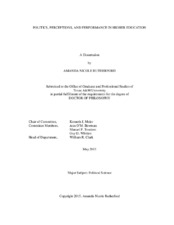| dc.description.abstract | This dissertation includes three studies devoted to disentangling the effects of managers—defined as university presidents—in four year institutions of higher education. In the United States, higher education as a whole is experiencing much uncertainty in a consistently changing external environment. State allocations have dropped substantially, forcing many colleges and universities to become more dependent on private funding and student tuition. At the same time, stakeholder groups have called for higher levels of accountability throughout the higher education sector in hopes of improving national standards of access, quality, and affordability. This funding instability and the political saliency of education have forced the leaders of these institutions to become part-politicians while determining how to strategically maintain a share of a competitive market. Drawing from political science and public administration theories, I examine whether and how presidents develop strategy and whether differences in managerial backgrounds have any effect on how institutions are managed using multivariate analysis on cross sectional time series data from research universities in the United States.
The research in this dissertation builds upon organizational-environmental fit literature to determine whether the fit between presidents’ former and current institutions has any effect on student retention, graduation, or degree completion. Findings imply that some fit is good but too much fit has negative consequences for performance. Additional analyses focuses on determining whether presidents implement strategic change or simply manage incremental shifts in institutional revenues, expenditures, and pricing given the current demands of the external environment. Interestingly, little strategy is detecting, suggesting that decision making aggregated at the institutional-level is perhaps random. Finally, this research explores the nonlinear determinants and effects of administrative intensity, a non-monetary phenomena often determined by presidents. Some types of administrative intensity can be helpful for boosting student performance but, this type of staffing can also have a negative effect on performance if it exceeds at given threshold. | en |


